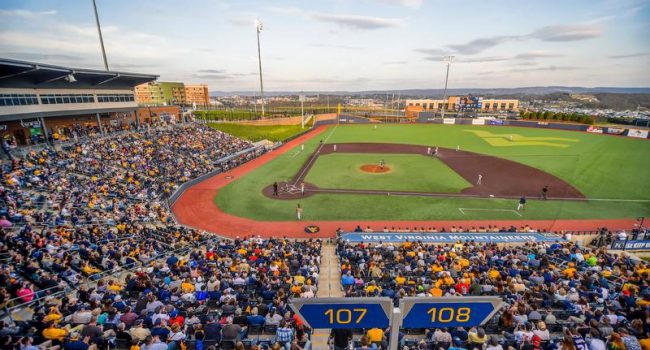GRANVILLE, W. Va. — They didn’t have to move a mountain to build Mon County Ballpark — they just had to build into the side of one after filling the abandoned mine that once occupied the area.
It’s a good thing they did. For West Virginia, no factor looms larger in the Mountaineers hosting NCAA postseason play for the first time since 1955 than the place it calls home.
For decades, the program’s home was Hawley Field, a cozy venue stuffed into the farthest northwest corner of the WVU campus. West Virginia coach Randy Mazey insists the place had its charms.
“I loved the atmosphere and energy we had in that place,” Mazey said. “The setting was beautiful with the Coliseum in the background. It’s a shame we were so landlocked that we couldn’t put this thing there.”
There were more than a few drawbacks, and not just for the folks living in the half-dozen or so houses bordering the ballpark behind the press box and down the first-base line. Or the fact the people living in those houses could watch ballplayers changing their clothes if so desired given the lack of actual locker rooms.
At least there was a bathroom. As in, one for the coaches, players and coaches to share.
“My favorite part of Hawley Field was if you had to use the restroom in the fourth inning, you had to stand in line with the fans and wait,” Mazey said. “They were asking me why I bunted when I was waiting my turn.
“We did a lot better when I was standing in the bathroom.”
The Mountaineers still used Hawley for practices when the current seniors were freshmen.
“We had the bullpens there and, well, I can’t even explain it,” said catcher Ivan Gonzalez. “The field was kind of old. No one had really been taking care of it because it was just used for ‘pens and BP. I think the first thing Coach Mazey said was ‘Watch your ankles.’ There was holes down there. There was all kinds of stuff.”
Despite Hawley’s limitations, the Mountaineers still produced future big-leaguers like Jedd Gyorko, Dustin Nippert, David Carpenter, John Means and Harrison Musgrave. But when WVU moved from the Big East to the Big 12, the new league made it clear the facility was unacceptable.
Earlier this week, former athletic director Oliver Luck told WAJR-AM that he issued an ultimatum: get a new stadium, or get rid of baseball.
“I called a meeting at the Coliseum and we had to decide. Were we going to drop the baseball program, or were we going to make a complete, 100-percent commitment to excellence?” Luck said. “I didn’t want any programs at the university to be playing with one hand tied behind their backs.”
With the help of Tax Increment Financing from Monongalia County, it became possible for the Mountaineers to have both hands available when it came to baseball. The park opened in 2015 and WVU has reached the NCAA tournament twice since, snapping a nearly two-decade drought.
“It’s a blessing getting this facility,” Gonzalez said, “and it’s just a beautiful place to play in.”
Mazey remains grateful for those who kept the program afloat long enough to make both Mon County Ballpark and a Morgantown Regional possible in the first place.
“Without the thousands of guys who played at Hawley Field and dressed out of the trunks of their cars because there’s no lockers, we’re not here,” Mazey said.
TWITTER @bigahickey




